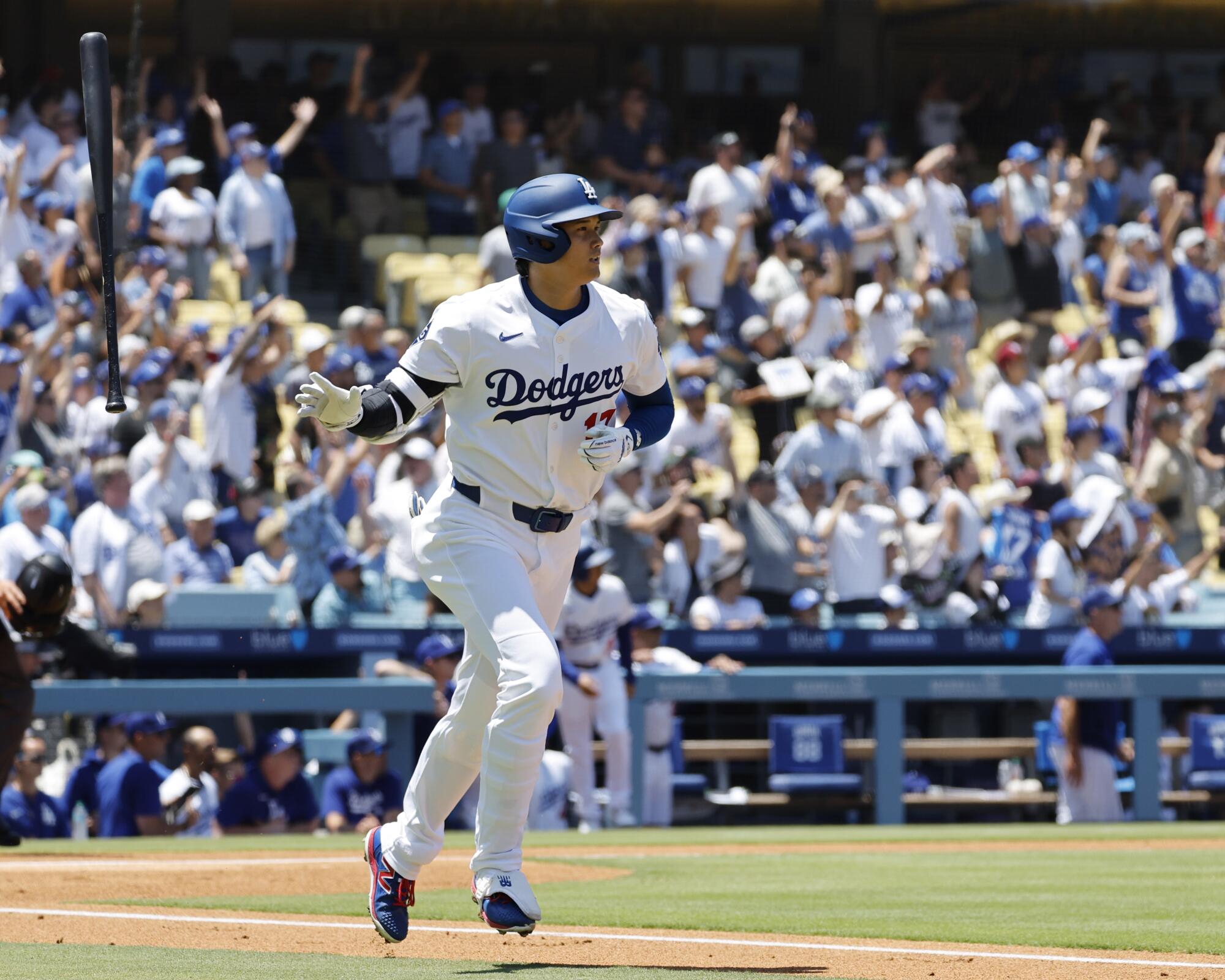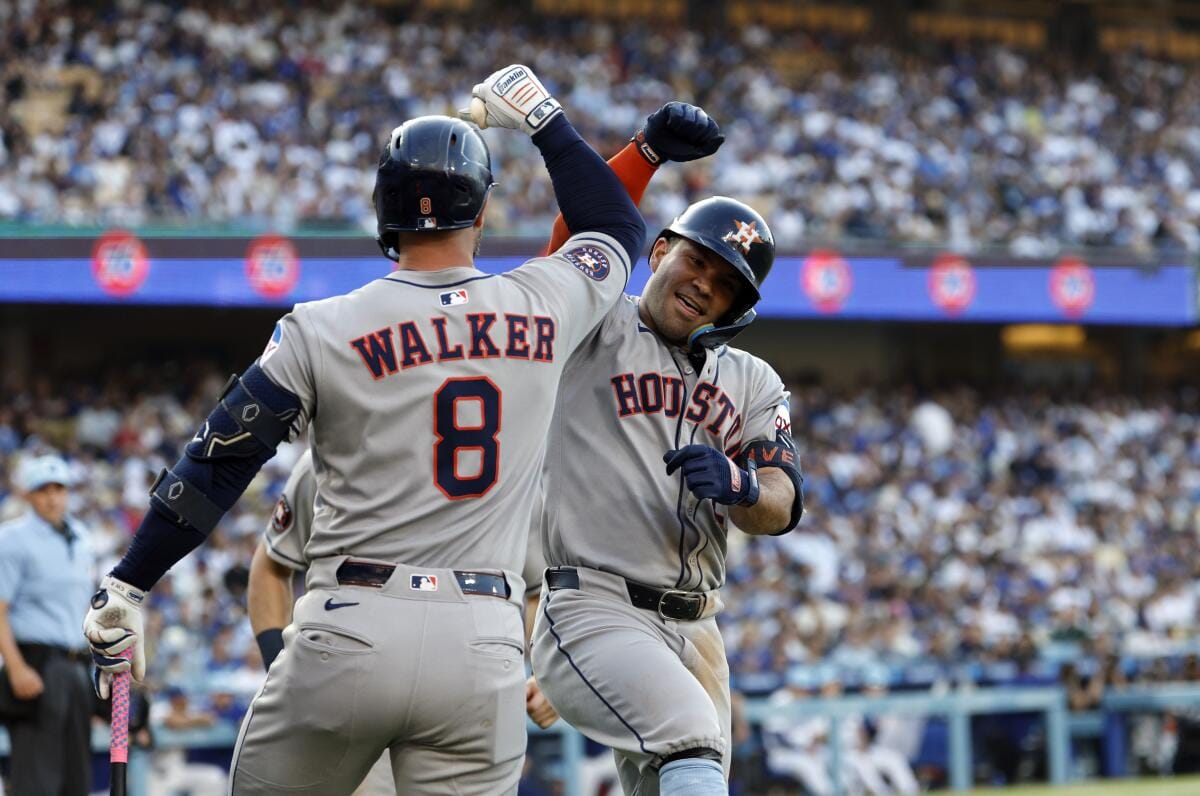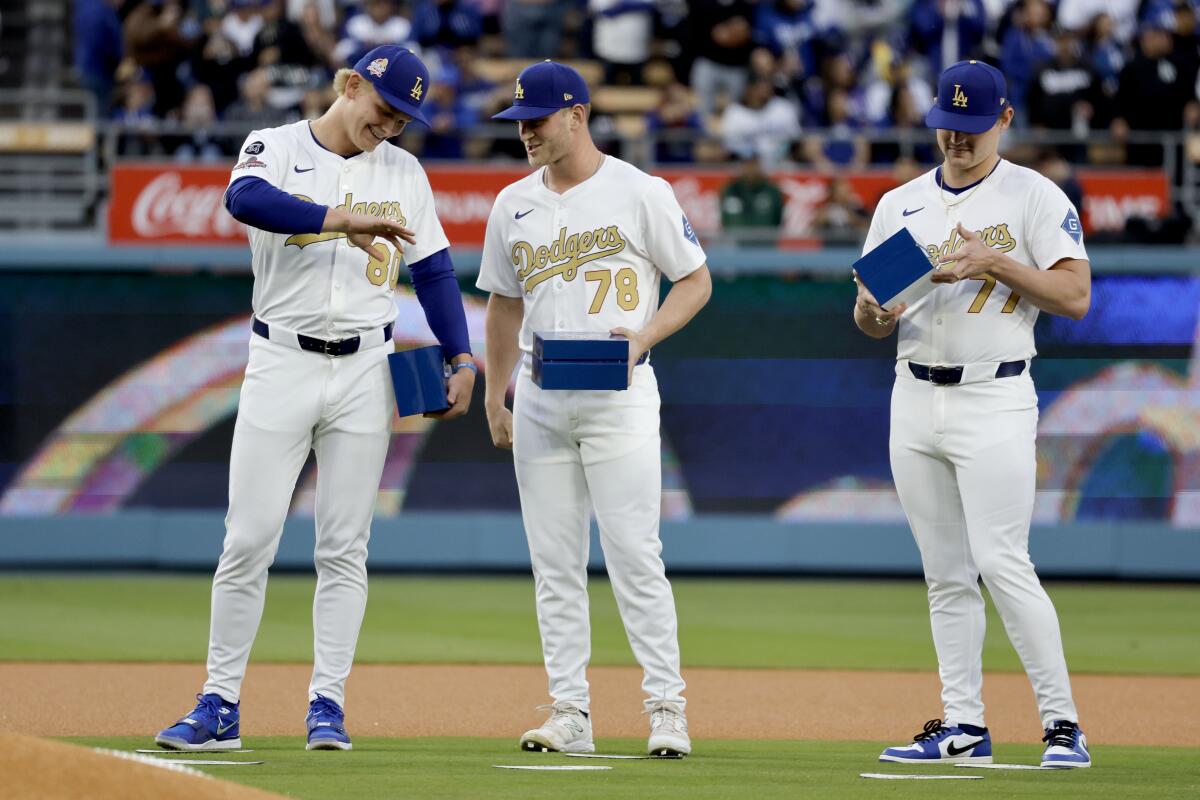Freddie Freeman’s walk-off hit saves the day and lifts the Dodgers
For 2 ½ hours of a sun-splashed Wednesday afternoon, the Dodgers were playing up to — or perhaps down to — recent expectations.
Their offense consisted mainly of a Shohei Ohtani home run while the starting pitching kept them in the game, but then everything appeared to go off the rails when manager Dave Roberts went to his bullpen.
This time there was a surprise ending though, with Freddie Freeman lining a two-strike, two-out, two-run single to left field to give the Dodgers a walk-off 4-3 win over the Minnesota Twins.
The win was just the second in six games since the All-Star break. But with the team beginning a nine-game, three-city road trip, its longest of the second half, Friday in Boston, Roberts believes the comeback could provide the spark the Dodgers have been missing.
“I hope so,” he said. “How we got here today, showing the fight, willing ourselves to get Freddie at bat. Freddie [taking] probably his best swing in a month. And to win a game like that, that’s momentum building.“
Maybe. Yet there was little reason to think the Dodgers were headed in the right direction entering the ninth inning.
Ohtani had given them the lead with a solo home run in the first inning. It was his fifth straight game with a home run, a career high that equaled the franchise record, giving him 37 for the season. Royce Lewis got that run back for the Twins in the third, leading off with his fifth home run of the season just inside the left-field foul pole. The score stayed that way until the seventh, when Tommy Edman looped a single over a drawn-in infield, putting the Dodgers back in front.
Which is when the game took a turn.
Tyler Glasnow, pitching for the third time since returning from the injury list, was brilliant again, holding the Twins to a run on three hits while striking out 12 batters over seven innings. But he was out of bullets after throwing 106 pitches, so Roberts went to the bullpen — and five batters later the Dodgers trailed, with the Twins scoring twice without ever getting the ball out of the infield.
Kirby Yates was first to the mound and he walked the bases loaded, missing the plate on 12 of his 18 pitches. Alex Vesia came in next to get Willi Castro to hit into a double play, but that allowed the tying run to score.
Pinch-hitter Harrison Bader then promptly untied it with a poorly hit ball that got over the leaping Vesia before dying on the infield grass as Brooks Lee raced home from third.
It was a script the Dodgers had seen before: Over the last four weeks, the team’s bullpen ERA has ballooned to 4.43. Only six teams in the majors entered Wednesday with a higher mark.
The rotation is largely to blame because, after losing three of his projected five starters in the season’s first two months, Roberts has had to use everything short of masking tape and bailing wire to keep a starting staff together. As a result, the Dodgers have used 16 starters this season and 37 pitchers overall.
Shohei Ohtani flips the bat after hitting a 441-foot home run to left-center in the first inning against the Minnesota Twins.
(Gina Ferazzi / Los Angeles Times)
That rotation is getting healthier now that Glasnow, who has missed most of the season because of an inflamed shoulder, could soon be rejoined in the rotation by two-time Cy Young Award winner Blake Snell, The left-hander, out since April 2 with shoulder inflammation, is scheduled to make his final minor-league rehab start Saturday.
Until now the bullpen has had to shoulder much of the load of those injuries: Dodger starters have thrown a big-league low 467 3/2 innings this season, averaging less than five innings a start, while their exhausted relievers have pitched a major-league-leading 452 2/3 innings.
So perhaps it’s no coincidence that in the last two days the team has lost two relievers, with Tanner Scott going on the injured list because of elbow inflammation and Ben Casparius limping off the mound with a right calf cramp, joining 11 pitchers already on the sidelines.
Casparius underwent an MRI exam, which was negative, and is expected to be available on the road trip. He admitted Wednesday that the bullpen’s recent struggles led him to try to pitch through the soreness, likely making the injury worse.
“Going through the back of my mind [was] kind of gutting it out,” he said. “I think you can look at it a bunch of different ways, but I’m not necessarily sure I put the team in the best spot.”
If Casparius failed to pick the team up, however, Freeman didn’t miss his shot.
After leaving the bases loaded in both the seventh and eighth innings, the Dodgers were down to their last strike when the slumping Mookie Betts beat out a weakly hit ball to third. The ball didn’t travel 90 feet but it went far enough for Betts to beat the throw by a whisker for his third hit in his last 29 at-bats.
The Twins then walked Ohtani intentionally before Esteury Ruiz worked a walk of his own to bring Freeman to the plate. And after taking two strikes, he fouled off a tough 1-2 pitch, then sliced a liner to left that fell in front of diving Bader to win the game.
“We needed that one,” said Freeman, who was hitting .210 in July before collecting two hits Wednesday.
The Dodgers celebrated by heading to the airport to board their charter to Boston, where they might be without Betts for at least a game.
Roberts said “everything is OK” with his shortstop but added that “there’s some things going on personally for him. We’ll see if he’s going to be there for the Friday game.”
As for the rest of the team, there’s hope the 6,300-mile trip, which includes stops in Cincinnati and Tampa Bay, will be long enough to get the Dodgers around the corner.
“Momentum is everything,” said Casparius, echoing his manager. “Maybe getting on the road and being uncomfortable might help us out a little bit in a weird way too. It’s a tough part of the year. Everybody around the league is going through this type of stuff.
“I think we’re going to turn a corner.”
Notes: Reliever Blake Treinen was scheduled to make back-to-back appearances for triple-A Oklahoma City on Wednesday and Thursday, and if things go well, he could re-join the Dodgers on the road trip. Treinen went on the injured list April 19 with forearm tightness. … Third baseman Max Muncy is scheduled to face live pitching at the Dodgers’ Arizona complex Thursday and could begin a minor-league rehab assignment next week, far sooner than expect. Muncy was the Dodgers’ hottest hitter when he sustained a bone bruise in his left knee three weeks ago. It was anticipated he would miss a month and half.



